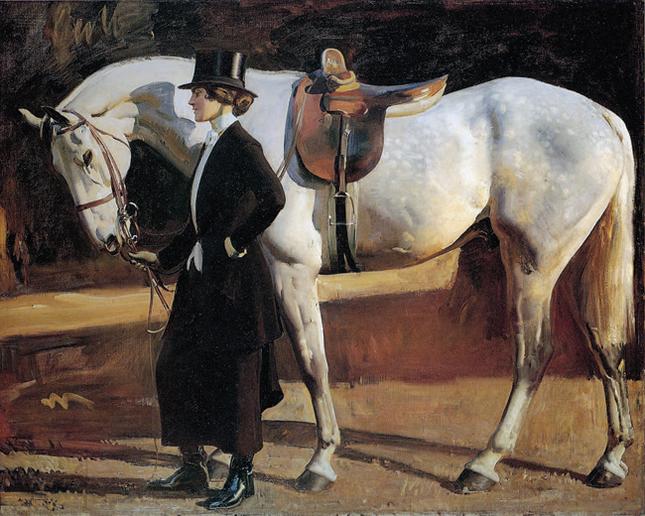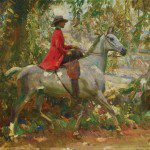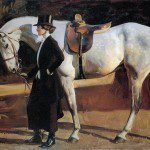‘Munnings: Out in the Open’ At the National Sporting Library and Museum
By • November 7, 2013 0 4598

Sir Alfred James Munnings (1878 – 1959) is regarded as among the true masters of equine art. His paintings of foxhunting, racing and equestrian society are benchmarks of the genre, exemplified by the artist’s unparalleled ability to capture otherwise ethereal moments of untamed grace. Animal, nature and man come together on his canvases in tenuous harmony, evincing both the grand theatricality and quiet naturalism of equestrian life.
Through Sept. 15, “Munnings: Out in the Open,” a retrospective of the artist’s work at the National Sporting Library and Museum in Middleburg, Va., finds new and rarely traveled terrain in the artist’s long and fruitful career. It exposes a man who kept himself well concealed behind a sweeping talent and gregarious character, the dedication and commitment that drove him to success, and the recurring solace he found in the transcendental expanses of the English countryside.
Though long since deceased, Munnings was drawn back into public attention in 1996 with the publication of “Summer in February,” by novelist Jonathan Smith. The book focuses on Munnings, introducing him to modern audiences at both ends of his life: as a successful, respected but conflicted man in the twilight of his career who harbors a dark personal secret, and as a brash, young Bohemian painter finding his voice and falling in love in an artist’s colony by an English fishing village.
This distressing secret, as many now know, was the suicide of his first wife Florence in 1914. Following her death, Munnings immediately abolished her from his personal history, excluding her even from his extensive three-volume autobiography.
All of this, of course, makes for a lyrically cinematic tale. And as it goes, “Summer in February” was adapted to a movie (with the excellent Dominic Cooper in the title role) that was released in the U.K. last June, and was screened in conjunction with this exhibit as part of a fundraiser at the NSLM last April before its release.
However, “Out in the Open” goes beyond the narrative limitations of a movie or a novel, offering audiences a three-dimensional portrait of the artist as told through the perspective of his paintings, which are more revealing and vulnerable than anything he or anyone ever wrote about him.
“We wanted to take advantage of the film and this recent popularity, but we also wanted to mount a real retrospective,” says Claudia Pfeiffer, head curator of the museum. “Munnings is such an important artist, especially for our museum—he was one of the few sporting artists who crossed over to a broader cultural and critical recognition.”
The time Munnings spent in the artist’s colony in the fishing village of Lamorna—where the book’s story is derived and where he and Florence spent so much time together—is where the exhibit begins, but it expands far deeper into the artist’s career, covering his work through the early 1950s. Still, that undeniable energy between his personal and professional life helped steer the development of the exhibit to focus on Munnings’ “passion paintings.”
“He made a healthy living off of equestrian commissions,” says Pfeiffer, “But we developed this exhibit around the paintings he pursued for his own passion, because that offers a better understanding of who he was as a man and an artist.”
Even the title of the show is a double entendre, referring both to the open-air painting style to which he was so devoted, and to the revealing of Munnings’ true character, which in many ways he concealed from his friends and patrons throughout his life.
Among the show’s highlights are two portraits of Florence on horseback and two portraits of his second wife Violet. These paintings alone show what a remarkable and dynamic range he had—both in color, tone and technique, as well as in the communication of mood and atmospheric texture to influence a scene. His creativity in fact feels forged by these relationships.
Florence is painted with an almost divine softness, first wistfully as she rides through the forest flecked with light through the eaves, and then in a harrowing portrait surrounded by grey skies and riding aside in black riding attire, which seems to foretell her sad fate just a few months later. This ephemeral portrayal, seemingly despite Munnings’ best painterly efforts, betrays the closeted fear he must have felt toward her afflicted spirit, as if at any moment she could—and ultimately did—disappear forever.
Then Violet. She holds the reigns of her horse firmly, standing in line with the creature with her foot turned out and her other hand on her waist, unquestionably in control of her time and place—a portrait of a 20th century woman. Indeed, Violet managed Munnings’ practical affairs, from money to property, sheltering the artist from mundane aspects of his life that always affected him negatively. Even in his clear affection towards her, in a garden portrait where she darns a pair of stockings, Munnings conveys a sense in her expression that she was a woman of great consequence and determination.
Out in the Open gives the audience a crisp and beautifully rendered biography of one of the last great painters of the classical European tradition. It not only broadens Munnings’ growing place in art and popular history, but amplifies it, validating the narrative of his life while clearing the fog of rumor and lore, and proving that nothing gets into the essence of an artist’s character like the artwork itself. Here, Munnings is brought magnificently to life on his own terms, using the very work that defined him.
- “My Horse is My Friend: the Artist’s Wife and Isaac,” 1922 oil on canvas, Pebble Hill Plantation, Thomasville, Georgia, © Castle House Trust (Sir Alfred Munnings Art Museum)



